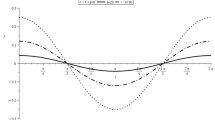Abstract
Infinite sequences defined with a finite alphabet are studied and it is shown that the set of sequences with bounded run-length has measure zero with respect to the Borel measure. Such sequences arise in many applications including digitization of certain linear systems involving flows on the circle and 2-torus, large scale simulation, and cryptology. They are basic objects of study in ergodic theory.
Similar content being viewed by others
References
DeStefano, A., Thitsa, M., & Martin, C. (2021). Output digitization of simple measure-preserving linear systems. Control Theory and Technology, 19(4), 430–443.
Nguyen, S., Wang, X., & Martin, C. (2016). A note on the number of long runs. Communications in Information and Systems, 16, 59–81.
Ornstein, D. (2013). Newton’s laws and coin tossing. Notices of the AMS, 60(4), 450–459.
Ornstein, D. S. (1974). Ergodic theory, randomness and dynamical systems. In Yale Mathematical Monographs 5. Yale University Press.
Austin, T. (2018). Measure concentration and the weak Pinsker property. Publications Mathématiques de l’IHÉS, 128, 1–119.
Cornfeld, I. P., Fomin, S. V., & Sinai, Ya. G. (1982). Ergodic theory. Grundlehren der Mathematischen Wissenschaften 245. Springer.
Cover, T. J., & Thomas, J. A. (1991). Elements of information theory. In: Wiley Series in Telecomunications. Wiley Interscience.
Shields, P. C. (1996). The ergodic theory of discrete sample paths. Graduate Studies in Mathematics 13. American Mathematics Society.
Dajani, K., & Kraaikamp, C. (2002). Ergodic theory of numbers. Carus Mathematical Monograph 29. The Mathematical Association of America.
Hardy, G. H., & Wright, E. M. (2008). An introduction to the theory of numbers (6th ed.). Oxford University Press.
Neumann, F., & Martin, C. (1976). The autocorrelation structure of Tausworthe pseudorandom number generators. IEEE Transactions on Computers, C–25, 460–464.
Cheng, D. (2009). Input-state approach to Boolean networks. IEEE Transactions on Neural Networks, 20(3), 512–521.
Cheng, D., & Qi, H. (2010). Linear representation of dynamics of Boolean networks. IEEE Transactions on Automatic Control, 55(10), 2251–2258.
Cheng, D., & Qi, H. (2010). State-space analysis of Boolean networks. IEEE Transactions on Neural Networks, 21(4), 584–594.
Cheng, D., Qi, H., & Li, Z. (2010). Analysis and control of Boolean networks. Springer.
Cheng, D. (2011). Disturbance decoupling of Boolean control networks. IEEE Transactions on Automatic Control, 56(1), 2–10.
Zhong, J., & Lin, D. (2015). A new linearization method for nonlinear feedback shift registers. Journal of Computer and System Science, 81, 783–796.
Author information
Authors and Affiliations
Corresponding author
Rights and permissions
About this article
Cite this article
DeStefano, A., Martin, C. The Borel measure of sequences with bounded run-length. Control Theory Technol. 20, 316–322 (2022). https://doi.org/10.1007/s11768-022-00102-1
Received:
Revised:
Accepted:
Published:
Issue Date:
DOI: https://doi.org/10.1007/s11768-022-00102-1



